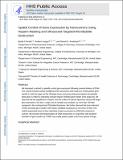Spatial Control of Gene Expression by Nanocarriers Using Heparin Masking and Ultrasound-Targeted Microbubble Destruction
Author(s)
Chertok, Beata; Langer, Robert S; Anderson, Daniel Griffith
DownloadAccepted version (903.8Kb)
Terms of use
Metadata
Show full item recordAbstract
We developed a method to spatially control gene expression following nonviral delivery of DNA. This method includes surface-modifying DNA nanocarriers with heparin to inhibit passive gene transfer in both the target and the off-target tissues and using ultrasound-targeted microbubble destruction (UTMD) to selectively activate heparin-inhibited gene transfer at the target site. We observed that the engraftment of heparin onto the surface of cationic liposomes reduced off-target gene expression in the liver, a major site of nanoplex accumulation, by more than 700-fold compared to the nonheparinized PEGylated liposomes. We further observed that tumor-directed UTMD increased gene transfer with heparin-modified nanoplexes by more than 10-fold. This method augmented tumor-to-liver selectivity of gene expression by 4000-fold compared to controls. We conclude that heparinization of DNA nanocarriers in conjunction with localized activation of gene transfer by UTMD may enable greater spatial control over genetic therapy. Keywords: gene delivery, spatial control, tumor targeting, gene nano carriers, heparin surface masking, microbubbles, ultrasound
Date issued
2016-07Department
Massachusetts Institute of Technology. Department of Chemical Engineering; Massachusetts Institute of Technology. Institute for Medical Engineering & Science; Harvard University--MIT Division of Health Sciences and Technology; Massachusetts Institute of Technology. Department of Biological Engineering; Koch Institute for Integrative Cancer Research at MITJournal
ACS Nano
Publisher
American Chemical Society (ACS)
Citation
Chertok, Beata et al. Spatial Control of Gene Expression by Nanocarriers Using Heparin Masking and Ultrasound-Targeted Microbubble Destruction 10, 8 (July 2016): 7267-7278 © 2016 American Chemical Society
Version: Author's final manuscript
ISSN
1936-0851
1936-086X